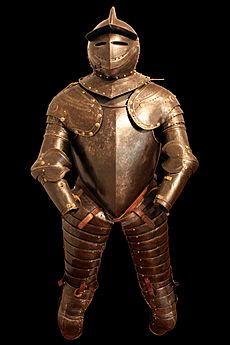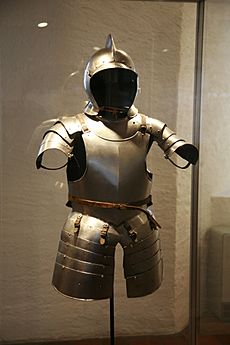Munition armour facts for kids

Munition armour was a special type of armour made in large amounts. It was kept ready in big storage places called armouries. This armour was used to equip many soldiers, both those who fought on foot (called foot soldiers) and those who rode horses (like horse riders or cuirassiers).
Contents
Why Munition Armour Was Needed
In the Late Middle Ages, fancy plate armour was very expensive. Each suit of armour was made just for one person, like a custom-made suit of clothes. Because of this, only rich people, like nobility, could afford it.
During wars like the English Civil War, a horse rider's (or cuirassier's) armour could weigh a lot, sometimes over 70 pounds! This made full plate armour too heavy and too costly for most soldiers. So, this type of armour started to disappear.
Armies and Mass Production
Around the 15th century, armies began to change. Countries started having "standing armies," which were groups of soldiers who were always ready to fight. These armies needed lots of equipment, including armour.
To equip so many soldiers, armour had to be made quickly and cheaply. This led to the creation of munition armour. It was mass-produced, meaning many pieces were made at once, often using standard designs.
How Munition Armour Was Made
Munition armour was usually made from iron. Sometimes, it included a small amount of phosphorus. This made the metal a little harder. The phosphorus might have come from the type of iron ore used or from the coal used in the smithing process.
One important thing about munition armour was that its pieces could be swapped. This meant that different parts of the armour were made to fit together easily, making repairs and replacements simpler.
Munition Armour in Japan
In Japan, during the Sengoku period (which was from the 15th to the 16th centuries), there were many wars. Armies grew very large, especially with lots of foot soldiers called ashigaru.
To equip these soldiers, huge amounts of simple munition armour were made. This included basic chest pieces (called dō) and helmets (called kabuto). Some armour was even designed to be foldable, like tatami armour. Tatami armour was made from small plates of iron or leather, often connected by chainmail. This made it easy to carry and store.
See also
- Almain rivet
- Swiss arms and armour


